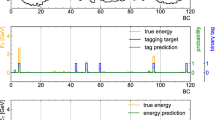Abstract
Optimal filtering is the crucial technique for the data analysis of transition-edge-sensor (TES) calorimeters to achieve their state-of-the-art energy resolutions. Filtering out the ‘bad’ data from the dataset is important because it otherwise leads to the degradation of energy resolutions, while it is not a trivial task. We propose a neural network-based technique for the automatic goodness tagging of TES pulses, which is fast and automatic and does not require bad data for training.





Similar content being viewed by others
Data Availability
The datasets generated during and/or analyzed during the current study are available from the corresponding author on reasonable request.
Notes
In the ideal case where all the pulses are truly identical except for scaling and truly random noises, the first component of PCA is expected to well represent the ideal pulse. However, in the real-world situation, those are not satisfied; pulse shapes may vary nonlinearly depending on energy, and noises are sometimes coherent due to cross-talks. It is impossible in principle to cover such variations using PCA because it is basically based on linear transformation. VAE tries to compress such variations without the constraint of linearity; that is, it is possible that a certain latent axis represents the non-linear energy dependence pulse heights. We think this expressive power to be the major advantage of VAE over PCA and other linear methods for the current problem setup.
References
D. P. Kingma, M. Welling, (2013). http://arxiv.org/abs/1312.6114
Y. Ichinohe, S. Yamada, MNRAS 487, 2874 (2019). https://doi.org/10.1093/mnras/stz1528
Y. LeCun, Y. Bengio, G. Hinton, Nature 521, 436 (2015). https://doi.org/10.1038/nature14539
I. Goodfellow, Y. Bengio, A. Courville, Deep Learning (MIT Press, Cambridge, MA, 2016)
G.E. Hinton, R.R. Salakhutdinov, Science 313, 504 (2006). https://doi.org/10.1126/science.1127647
M. Abadi et al., TensorFlow: Large-Scale Machine Learning on Heterogeneous Systems (2015). http://download.tensorflow.org/paper/whitepaper2015.pdf (see also https://www.tensorflow.org/). Accessed 8 Apr 2022
V. Nair, G. E. Hinton, in Proceedings of the 27th International Conference on Machine Learning (ICML- 10), ed. by J. Fürnkranz, T. Joachims (Omnipress, Madison, WI, 2010) p. 807. http://www.icml2010.org/papers/432.pdf. Accessed 8 Apr 2022
W.B. Doriese, J.S. Adams, G.C. Hilton, K.D. Irwin, C.A. Kilbourne, F.J. Schima, J.N. Ullom, AIP Conf. Proc. 1185, 450 (2009). https://doi.org/10.1063/1.3292375
D. P. Kingma, J. Ba, (2014), http://arxiv.org/abs/1412.6980)
Acknowledgements
We thank the referees for their constructive suggestions and comments. This work was partially supported by the Grants-in-Aid for Scientific Research by the Japan Society for the Promotion of Science with KAKENHI Grant Nos. 18H05458, 20K14524, and 20K20527.
Author information
Authors and Affiliations
Corresponding author
Additional information
Publisher's Note
Springer Nature remains neutral with regard to jurisdictional claims in published maps and institutional affiliations.
Rights and permissions
About this article
Cite this article
Ichinohe, Y., Yamada, S., Hayakawa, R. et al. Application of Deep Learning to the Evaluation of Goodness in the Waveform Processing of Transition-Edge Sensor Calorimeters. J Low Temp Phys 209, 1008–1016 (2022). https://doi.org/10.1007/s10909-022-02719-7
Received:
Accepted:
Published:
Issue Date:
DOI: https://doi.org/10.1007/s10909-022-02719-7




